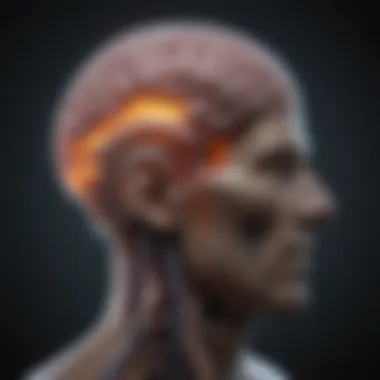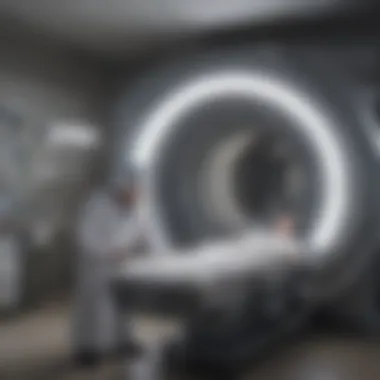Seizure Protocol MRI: Comprehensive Overview


Intro
The intersection of magnetic resonance imaging (MRI) and seizure disorders presents a nuanced landscape worthy of exploration. Understanding how seizure protocols are structured is critical for both diagnosis and management of related conditions. This article aims to provide a thorough breakdown of the methodologies and recent advancements in MRI techniques that are specifically tailored for studying seizures. With the rising prevalence of epilepsy and other seizure disorders, it is paramount for medical professionals, researchers, and students to familiarize themselves with the latest in imaging protocols and interpretations.
In this piece, we delve into various standard practices employed during MRI procedures associated with seizure analysis, alongside a discussion of the variations that may occur based on specific patient needs or conditions. This exploration extends beyond the technical aspects of these imaging protocols, as it also considers the implications of new technological innovations that can impact results.
Furthermore, we will explore patient preparation processes that contribute to the efficacy of MRI in seizure diagnosis, highlighting the significance these practices bear in achieving accurate results. We will synthesize findings from recent research and technological advancements to paint a picture of the current status of MRI in the clinical landscape of epilepsy. Through this comprehensive overview, readers will gain valuable insights into how protocols are designed, how they vary, and how they continue to evolve in tandem with advances in medical imaging technology.
Understanding Seizure Disorders
Understanding seizure disorders is pivotal as it builds the foundation for interpreting how MRI protocols are employed in diagnosing these conditions. Seizures can greatly impact the quality of life of individuals, and comprehending their nature is essential for providing effective treatment. This section will elucidate key aspects like definitions, types, epidemic statistics, and causes that characterize seizure disorders. Such knowledge is not merely academic; it has practical implications for treatment, research, and patient care.
Definition and Types of Seizures
Seizures occur due to abnormal electrical activity in the brain. They manifest in various forms, each with distinct features. The primary categories include:
- Focal Seizures: These originate in a specific region of the brain. Patients may experience localized symptoms, including motor changes or altered sensations, depending on the area affected.
- Generalized Seizures: These engage both hemispheres of the brain from the outset. Examples include tonic-clonic seizures, which involve a loss of consciousness and muscle contractions, and absence seizures, which are characterized by brief lapses in awareness.
Understanding these distinctions is vital, for they inform diagnostic protocols and treatment options. The variability in seizure presentations underscores the need for precise imaging techniques such as MRI.
Epidemiology of Seizures
Seizures are relatively common in the general population. Statistics indicate that about 1 in 10 people will experience a seizure in their lifetime, with various causes including epilepsy, head trauma, and infections. The incidence rates may vary, with certain demographic groups, such as infants and the elderly, showing higher frequencies.
Moreover, seizure disorders are prevalent worldwide. The World Health Organization estimates that nearly 50 million people are affected globally, illustrating the widespread nature of this health challenge. Such prevalence drives the necessity for effective assessment methods, prompting the integration of MRI into diagnostic protocols.
Etiology of Seizures
The causes of seizures are diverse and often multifactorial. They can be classified into several categories:
- Genetic Factors: Some individuals have a hereditary predisposition to seizures, often linked to genetic mutations.
- Structural Abnormalities: Birth defects or traumatic injuries that affect brain structure can lead to seizure activity.
- Metabolic Disturbances: Conditions such as low blood sugar or electrolyte imbalances may provoke seizures.
- Infections: CNS infections like meningitis or encephalitis can precipitate seizures.
Identifying the etiology is complex but necessary for developing targeted treatment plans. This understanding subsequently influences the specific recommendations for MRI protocols, aiming for an accurate assessment of underlying brain conditions.
Role of MRI in Seizure Diagnosis
Magnetic Resonance Imaging (MRI) plays a pivotal role in the diagnosis and management of seizure disorders. Understanding the importance of MRI in this context is essential for healthcare providers and researchers alike. MRI offers detailed images of the brain, which can reveal abnormalities such as tumors, structural malformations, and other pathologies that may contribute to seizure activities. This imaging modality is particularly valuable due to its non-invasive nature, allowing for repeated assessments without the risk of radiation exposure associated with other imaging techniques like CT scans.
The primary benefits of MRI in seizure diagnosis include:
- High spatial resolution that enables the visualization of intricate brain structures.
- Ability to detect subtle changes in brain tissue that may be associated with different seizure types.
- Capacity for functional imaging, providing insights into areas of the brain that may be involved during seizure events.
In addition to these advantages, the use of MRI can also inform treatment decisions. Identification of a structural cause for seizures may lead to specific interventions, such as surgical options for resectable lesions. Overall, the integration of MRI into the seizure assessment process is critical for providing precise diagnoses and enhancing patient outcomes.
Indications for MRI in Seizure Assessment
MRI is typically indicated in several scenarios concerning seizure assessments. These include:
- New Onset Seizures: MRI is essential when patients present with new seizure onset, especially in adults. This is to rule out potential structural causes, such as tumors or strokes.
- Changes in Seizure Pattern: If a patient experiences an unusual progression in their seizure type or frequency, MRI can help identify any underlying pathology.
- Resistant Seizures: In cases where seizures are refractory to treatment, MRI can provide crucial insights into whether there is an identifiable cause that might warrant consideration of surgical intervention.
- Acute Onset with Neurological Changes: For sudden seizure onset accompanied by neurological deficits, MRI is key to diagnosing conditions like encephalitis or vascular complications.


The careful consideration of these indications ensures that patients receive timely and appropriate imaging, facilitating accurate diagnoses and targeted treatments.
Utility of MRI in Differentiating Seizure Types
Differentiating among various seizure types is critical for formulating effective treatment plans. MRI contributes significantly to this differentiation in the following ways:
- Structural Findings: Different types of seizures can correlate with specific structural anomalies in the brain. For instance, mesial temporal lobe epilepsy often shows characteristic changes identifiable on MRI.
- Localization: MRI assists in localizing the seizure focus, crucial for patients being considered for epilepsy surgery. Accurate identification of abnormal areas can directly influence surgical outcomes.
- Evaluation of Comorbidities: Many patients have co-existing neurological conditions that can complicate seizure presentations. MRI helps differentiate these conditions, clarifying the clinical picture and guiding treatment.
In summary, the utility of MRI in seizure diagnosis extends beyond mere identification of a structural cause. By providing essential information about the nature and differentiation of seizures, MRI becomes a valuable tool in patient management.
"Understanding the intricate relationship between MRI findings and seizure types is fundamental for clinicians dealing with epilepsy. The depth of insight MRI can offer is unparalleled in seizure disorders."
MRI remains an indispensable component of seizure diagnostics, continually evolving as technology advances, aiming to improve patient care in neurology.
MRI Protocol for Seizure Evaluation
MRI protocols for seizure evaluation play a crucial role in understanding and managing seizure disorders. These protocols provide a structured approach to capture detailed brain images, which are essential for identifying abnormalities that may cause or influence seizure activity. Inaccurate or incomplete imaging can lead to misdiagnosis or oversight of underlying conditions. Therefore, adopting standardized MRI protocols is vital for accurate diagnosis and treatment planning.
The importance of MRI protocols extends beyond mere imaging; they guide clinicians in interpreting results with a clear framework. This consistency helps in identifying key pathological changes associated with different seizure types, facilitating appropriate therapeutic interventions. Moreover, understanding these protocols allows professionals to refine imaging strategies, tailoring examinations according to individual patient needs.
Overview of Standard MRI Protocols
Standard MRI protocols typically involve several imaging sequences designed to provide comprehensive information about the brain. The most common sequence used is T1-weighted imaging, which offers detailed anatomical views. T2-weighted imaging follows, capturing fluid-filled structures and helping identify edema or lesions. In addition, contrast-enhanced imaging can be utilized to highlight areas of abnormal vascularity or breakdown of the blood-brain barrier.
Radiologists often combine these standard protocols with templated approaches, which include specific patient histories and clinical findings. By adapting protocols to the clinical context, more relevant diagnostic information can be gleaned.
Additional Sequences for Comprehensive Assessment
MRI imaging can be further enhanced by incorporating additional sequences to improve diagnostic yield.
Diffusion-weighted Imaging
Diffusion-weighted imaging (DWI) focuses on the movement of water molecules in brain tissue. It is particularly sensitive to acute ischemic changes and can uncover subtle lesions that standard sequences may miss. This characteristic positions DWI as a beneficial tool in seizure evaluation, especially in cases of suspected acute cerebral events.
The unique feature of DWI is its ability to produce images reflecting microscopic changes in the brain. However, one disadvantage is its susceptibility to motion artifacts, which can skew results or compromise clarity, making patient cooperation vital during scanning.
Flair Imaging
Fluid-attenuated inversion recovery (FLAIR) imaging is another important sequence in MRI protocols. It effectively suppresses cerebrospinal fluid signal and allows better visualization of lesions near fluid-filled spaces. This is particularly useful in identifying cortical lesions that may be implicated in seizure activity.
The key characteristic of FLAIR imaging is its ability to highlight abnormalities that appear iso-intense on T2-weighted images. Yet, a limitation is that while it effectively identifies certain types of lesions, it may not always delineate fine structural details clearly.
Functional MRI
Functional MRI (fMRI) evaluates brain activity by detecting changes in blood flow. It assesses regions that become active during seizure-related tasks, aiding in understanding functional connectivity and identifying possible seizure foci.
The significant aspect of fMRI is its capability to provide real-time data on cerebral activity during specific tasks. This allows for a dynamic look at potential triggers for seizure events. However, fMRI is more complex to interpret than anatomical scans, resulting in potential challenges for clinicians in correlating functional data with anatomical findings.
Preparing Patients for MRI Procedures
The preparation phase for patients undergoing MRI procedures is critical to ensure optimal imaging and minimize complications. This phase involves multiple elements, including pre-procedural assessments, effective communication, and addressing patient concerns. Understanding these aspects helps healthcare providers manage the patient experience better and contributes to the overall success of the MRI process.


Pre-MRI Assessment and Screening
Before proceeding with an MRI, it is necessary to conduct a thorough assessment and screening of the patient. This assessment serves multiple purposes:
- Identifying contraindications: Certain medical devices, like pacemakers or cochlear implants, may interfere with MRI safety. Identifying these before the procedure helps prevent harm.
- Evaluating allergies and sensitivities: Some patients may have allergies to contrast agents used in MRI scans. By documenting these, medical teams can make informed decisions about the use of these materials.
- Reviewing medical history: A detailed history allows healthcare professionals to understand the patient's condition better. This may influence the imaging protocol or the need for sedatives.
A pre-MRI questionnaire is typically utilized to gather relevant information. It should address medical history, current medications, and any physical limitations. Additionally, staff should communicate the questions clearly and encourage open dialogue. This forms trust and increases the likelihood that patients will disclose necessary details.
Managing Patient Anxiety and Safety
Anxiety is common among patients awaiting medical procedures, including MRI scans. Numerous strategies can be employed to alleviate patient stress:
- Providing education: Explaining the MRI process can demystify it for patients. Clarity about what to expect – from the machinery noise to the duration of the procedure – can reduce fear.
- Creating a comforting environment: The MRI room should be welcoming. Soft lighting and calming colors can create a more relaxed atmosphere, which may ease anxiety levels.
- Employing relaxation techniques: Guided imagery or deep breathing exercises can help patients relax before the procedure begins. Staff can offer support during this time.
Moreover, ensuring safety during the MRI procedure is paramount. Medical personnel must monitor patients for adverse reactions, especially in those undergoing sedation or contrast use. Pre-procedural briefings should outline the steps needed in emergency situations, ensuring all team members are prepared.
Understanding patient needs during the MRI preparation phase enhances care quality and patient satisfaction.
Interpreting MRI Results in the Context of Seizures
Interpreting MRI results is a crucial step in the management of patients with seizure disorders. MRI is essential not only for diagnosis but also for guiding treatment decisions. The appearance of specific brain structures on MRI can provide valuable insights into the underlying causes of seizures, such as structural anomalies or the presence of lesions.
When neurologists evaluate MRI scans of patients experiencing seizures, they look for common indicators of pathology. These indicators can reveal abnormalities like cortical dysplasia, tumors, vascular malformations, and other neurological conditions that may provoke seizure activity. The existence of these anatomical abnormalities can often help correlate the seizure onset zone, facilitating targeted intervention strategies.
Furthermore, MRI findings can also be instrumental in assessing the prognosis of seizure disorders. For some patients, particularly those with surgery-refractory epilepsy, the identification of a removable lesion may present an opportunity for surgical intervention. Conversely, certain findings might suggest a more chronic condition requiring a different management approach. Thus, understanding the details and implications of MRI results is vital for optimizing patient outcomes.
The clarity and precision of MRI results are essential. They not only guide treatment but also influence the long-term management of seizure disorders.
Identifying Anomalies and Pathologies
Identifying anomalies and pathologies on MRI scans is a critical component of assessing seizure disorders. This process involves a systematic review of the images to pinpoint specific structural abnormalities that may contribute to seizure activity. Radiologists and neurologists collaborate in this domain, applying their expertise to discern various pathologies.
Common findings might include:
- Cortical dysplasia: A developmental malformation of brain tissue that often relates to focal epilepsy.
- Hippocampal sclerosis: Characterized by loss of neurons and gliosis, frequently associated with temporal lobe epilepsy.
- Vascular lesions: Such as arteriovenous malformations or cavernous malformations can also be implicated.
These conditions can significantly inform both the diagnosis and management. For example, the presence of cortical dysplasia usually suggests a need for surgical consideration. Conversely, identifying a secondary cause of seizures may alter the entire treatment plan, underscoring the importance of careful analysis.
The Role of Radiologists in Diagnosis
Radiologists play a vital role in the diagnosis of seizure disorders through their interpretation of MRI scans. Their expertise allows them to accurately identify relevant anomalies and convey this information to the treating neurologist. This collaboration enhances the overall diagnostic process and patient care.
Radiologists utilize advanced imaging techniques and their extensive understanding of brain anatomy to determine the appropriate next steps for patients. Key responsibilities include:
- Providing detailed reports: These reports guide neurologists in making clinical decisions based on the presence or absence of specific pathologies.
- Collaborating with neurologists: Continuous dialogue ensures that clinicians understand the imaging findings in the context of the patient's clinical presentations.
- Staying updated with advances: The rapid development in MRI techniques requires radiologists to remain knowledgeable about new protocols and technologies.
Limitations and Considerations of MRI in Seizure Management
The role of magnetic resonance imaging (MRI) in the assessment and management of seizure disorders is significant. However, it is also essential to recognize the limitations and considerations associated with MRI in this context. Understanding these aspects is critical for healthcare professionals to make informed decisions.


MRI provides high-resolution images of the brain, aiding in identifying structural abnormalities that can lead to seizures. Yet, certain limitations may influence the overall diagnostic efficacy.
Technical Limitations of MRI
MRI technology is not without its constraints. Some of the notable technical limitations include:
- Susceptibility to Motion Artifacts: Patients may experience discomfort during the scan, leading to involuntary movements. Such movements can obscure the quality of the images, which may hinder effective interpretation.
- Field Strength Variability: Different MRI machines operate at varying Tesla strengths. Lower field strength systems may not capture fine details, making them inadequate for detailed assessment of potential seizure foci.
- Limitations with Certain Patient Populations: Patients with claustrophobia or those who cannot remain still may require sedation. Sedation can complicate the evaluation, introducing variables that affect the outcomes.
- Inability to Assess Functional Dynamics: MRI is primarily a structural imaging technique. While it excels in providing detailed anatomical views, it does not offer functional insights into brain activity during a seizure. This limitation can hinder understanding the dynamics of seizure generation and propagation.
In summary, while MRI is invaluable in diagnosing seizure disorders, clinicians must remain aware of these technical limitations to manage expectations accordingly.
Alternative Imaging Techniques
Given the limitations of MRI, exploring alternative imaging techniques can be beneficial. Some of these alternative modalities include:
- Computed Tomography (CT): CT scans are quicker and more accessible than MRIs, making them useful for initial assessments in emergency settings. However, they have lower resolution and may miss subtle structural changes.
- Electroencephalography (EEG): EEG remains the gold standard for evaluating seizure activity. It measures electrical activity in the brain, providing insights into seizure types and foci. Combining EEG with MRI enhances diagnostic accuracy.
- Positron Emission Tomography (PET): PET imaging can identify areas of altered metabolism that may be associated with seizure activity. It is particularly useful in evaluating epilepsy where metabolic changes correlate with seizure occurrence.
- Single Photon Emission Computed Tomography (SPECT): SPECT imaging can help visualize blood flow changes in the brain areas involved in seizures. It is often used during seizure events, offering a functional perspective that MRI lacks.
Emerging Technologies in MRI for Seizure Diagnosis
The advancements in magnetic resonance imaging (MRI) are reshaping the diagnostic landscape for seizure disorders. These emerging technologies are crucial as they enhance the ability to detect and understand the underlying causes of seizures. Exploring the latest developments in imaging techniques provides valuable insight into the potentials these technologies bring for more accurate diagnoses and personalized treatment strategies.
Advancements in Imaging Techniques
Recently, a variety of innovations have emerged in MRI technology, improving its application in seizure diagnostics. Innovations such as high-field MRI scanners and advanced imaging sequences are critical in providing clearer and more detailed images of the brain. These techniques allow radiologists and neurologists to identify structural abnormalities that may contribute to seizure activity.
In particular, high-resolution imaging helps in differentiating between types of lesions that could trigger seizures. Techniques like ultra-high-field MRI utilize stronger magnetic fields to enhance image resolution. This allows for more precise visualization of brain structures. Moreover, advancements in magnetic resonance spectroscopy enable the analysis of brain metabolites, which can offer insights into metabolic dysfunctions associated with seizure disorders.
Additionally, real-time MRI is gaining traction. This technology can capture dynamic changes in brain activity, which is vital during seizure episodes. By allowing observation of the brain's function during seizures, it provides crucial context that static images might miss.
Potential Future Applications
The future of MRI technologies for seizure diagnosis holds great promise. Emerging applications could significantly improve clinical outcomes. For instance, machine learning and artificial intelligence are beginning to play a role in the analysis of MRI scans. These tools can assist in identifying patterns associated with various seizure disorders that may go unnoticed by human observers alone.
Furthermore, the integration of functional MRI (fMRI) into routine practices could pave the way for understanding how different brain regions interact during seizure activities. Mapping these interactions could provide new strategies for intervention and treatment, potentially transforming patient care practices.
Emerging MRI technologies will not only enhance precision in identification but will also refine management approaches in patients with seizure disorders.
Moreover, optical imaging combined with MRI could yield multifaceted perspectives on brain function and pathology. Such innovations could enable targeted therapies that are specific to the type of seizure disorder present.
The End
In this article, we examined the pivotal role of MRI protocols in managing seizure disorders. The significance of this topic cannot be understated. MRI serves as a powerful tool for clinicians, allowing for detailed visualization of the brain's structure, which is essential in diagnosing and managing various seizure types. As this article outlines, understanding the complexities of MRI techniques enhances the efficacy of patient care and aids in refining treatment decisions.
Summary of Key Points
The article highlighted several critical aspects of MRI in the context of seizure disorders. Key points include:
- MRI's Utility: MRI is instrumental in identifying brain anomalies that relate to seizure activity.
- Protocols: The article detailed standard protocols and additional imaging techniques, such as diffusion-weighted imaging and functional MRI, which improve diagnostic accuracy.
- Patient Preparation: Effective pre-MRI screening and patient management are critical to mitigate anxiety and ensure safety during the procedure.
- Limitations: Acknowledging the limits of MRI technology and considering alternative imaging methods are essential for comprehensive evaluation.
- Emerging Technologies: Continued advancements in imaging techniques are rapidly transforming how seizure disorders are understood and managed.
By summarizing these key points, we underscore the need for continuous education and adaptation in clinical practices.
Future Directions in Seizure Protocol MRI Research
Looking ahead, the future of seizure protocol MRI research appears promising. Several areas warrant exploration:
- Integration of AI: Artificial intelligence can enhance imaging analysis, helping in the faster identification of seizure-related abnormalities.
- Longitudinal Studies: Research could focus on the long-term impacts of different MRI protocols on seizure management outcomes.
- Patient-Centric Approaches: Aspects related to patient comfort and cooperation during MRI procedures should receive more attention. Developing protocols that reduce anxiety and improve patient experience could lead to better diagnostic results.
- Cross-Disciplinary Collaboration: Increased collaboration among neurologists, radiologists, and researchers may catalyze innovative approaches to seizure diagnostics.
The shifting landscape of medical imaging invites a thorough re-evaluation of current practices, encouraging a collective effort in research specializations. This collaborative approach holds potential to revolutionize seizure diagnosis and management.















